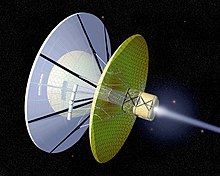
Back السفر بين النجوم Arabic Vol espacial interestel·lar Catalan گەشتی نێوەستێرەیی CKB Mezihvězdný let Czech Interstellar rejse Danish Interstellare Raumfahrt German Viaje interestelar Spanish Tähtedevaheline lend Estonian Izarrarteko bidaia Basque سفر میانستارهای Persian

| Part of a series on |
| Spaceflight |
|---|
 |
|
|
Interstellar travel is the hypothetical travel of spacecraft from one star system, solitary star, or planetary system to another. Interstellar travel is expected to prove much more difficult than interplanetary spaceflight due to the vast difference in the scale of the involved distances. Whereas the distance between any two planets in the Solar System is less than 55 astronomical units (AU), stars are typically separated by hundreds of thousands of AU, causing these distances to typically be expressed instead in light-years. Because of the vastness of these distances, non-generational interstellar travel based on known physics would need to occur at a high percentage of the speed of light; even so, travel times would be long, at least decades and perhaps millennia or longer.[1]
As of 2024[update], five uncrewed spacecraft, all launched and operated by the United States, have achieved the escape velocity required to leave the Solar System as part of missions to explore parts of the outer system. They will therefore continue to travel through interstellar space indefinitely. However, they will not approach another star for hundreds of thousands of years, long after they have ceased to operate (though in theory the Voyager Golden Record would be playable in the event that the spacecraft is retrieved by an extraterrestrial civilization).
The speeds required for interstellar travel in a human lifetime far exceed what current methods of space travel can provide. Even with a hypothetically perfectly efficient propulsion system, the kinetic energy corresponding to those speeds is enormous by today's standards of energy development. Moreover, collisions by spacecraft with cosmic dust and gas at such speeds would be very dangerous for both passengers and the spacecraft itself.[1]
A number of strategies have been proposed to deal with these problems, ranging from giant arks that would carry entire societies and ecosystems, to microscopic space probes. Many different spacecraft propulsion systems have been proposed to give spacecraft the required speeds, including nuclear propulsion, beam-powered propulsion, and methods based on speculative physics.[2]
Humanity would need to overcome considerable technological and economic challenges to achieve either crewed or uncrewed interstellar travel. Even the most optimistic views forecast that it will be decades before this milestone is reached. However, in spite of the challenges, a wide range of scientific benefits are expected should interstellar travel become a reality.[3]
Most interstellar travel concepts require a developed space logistics system capable of moving millions of tonnes to a construction/operating location, and most would require gigawatt-scale power for construction or power (such as Star Wisp– or Light Sail–type concepts). Such a system could grow organically if space-based solar power became a significant component of Earth's energy mix. Consumer demand for a multi-terawatt system would create the necessary multimillion tonne/year logistical system.[4]
- ^ a b Mauldin, John H. (May 1992). Prospects for interstellar travel. Published for the American Astronautical Society by Univelt.
Interstellar travel.
- ^ "Interstellar Travel". www.bis-space.com. Archived from the original on 16 June 2017. Retrieved 16 June 2017.
- ^ Crawford, I. A. (2009). "The Astronomical, Astrobiological and Planetary Science Case for Interstellar Spaceflight". Journal of the British Interplanetary Society. 62: 415–421. arXiv:1008.4893. Bibcode:2009JBIS...62..415C.
- ^ Conclusion of the 2016 Tennessee Valley Interstellar Workshop Space Solar Power Working Track run by Peter Garretson & Robert Kennedy.
© MMXXIII Rich X Search. We shall prevail. All rights reserved. Rich X Search